Discovering Iran’s UNESCO World Heritage Sites
A Journey Through History and Culture
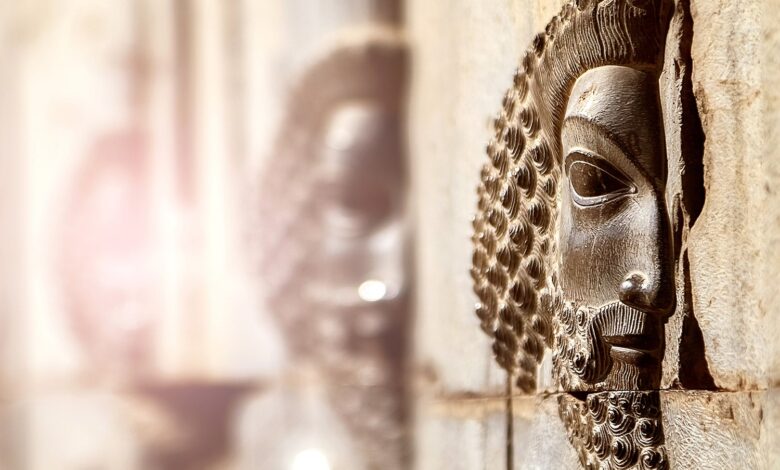
UNESCO’s World Heritage Convention aims to protect and conserve the cultural and natural heritage of every country as universal assets of humanity. By registering significant historical and natural landmarks from various parts of the world, UNESCO has created an interconnected network of elements possessing Outstanding Universal Value. This forms a unique map showcasing wonders of the world, and following these paths unveils some of the finest examples of architectural, historical, and aesthetic treasures across the globe.
Iran’s cultural heritage, in particular, narrates tales of grand empires, dynamic history, mystical scholars, and artistic achievements that have left a profound impact on the rest of the world. Situated at the crossroads of Asia, Europe, and Africa, Iran emerged as a cradle of civilization, embodying captivating contrasts. No journey to Iran is truly complete without delving into its layers of remarkable past. Following the path outlined by UNESCO’s World Heritage List provides a profound understanding of this enduring nation.
Contents
Tchogha Zanbil
Tchogha Zanbil holds the distinction of being the first Iranian site to be inscribed on UNESCO’s World Heritage List. This sacred edifice, dating back to the Elamite period around 1250 B.C., stands as a highly esteemed example of ziggurat architecture which is also distinct from Babylonian and Assyrian ziggurats. The massive temple was constructed during the reign of Untash Napirisha to honor the Elamite god Inshushinak. Its brick inscriptions revealed important details about the Elamite era. The complex also holds eleven temples of lesser Elamite gods and goddesses.
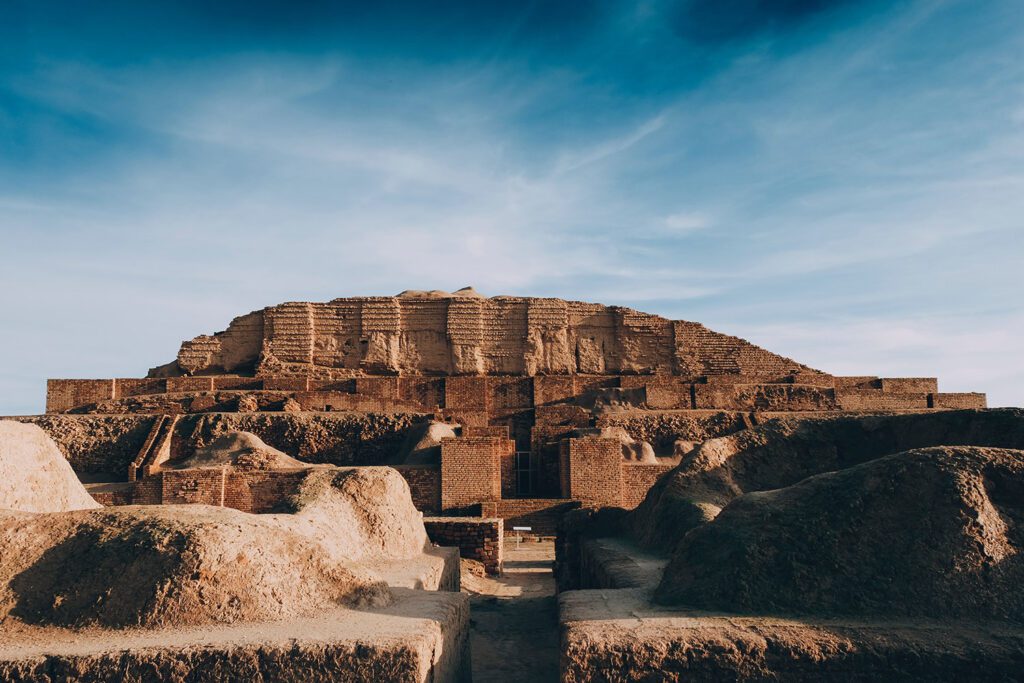
Persepolis
Persepolis, located near Marvdasht in Fars Province, Iran, stands as a magnificent symbol of the glory of Persian culture and civilization during the Achaemenid era. In the past, Persepolis was a splendid and thriving city, serving as the seat of government for the Achaemenid kings.

The construction of the palaces of Persepolis began over 500 years B.C., and continued for about 150 years thereafter. Following the invasion of Alexander the Great, the palaces of Persepolis were set ablaze by the Greek king, and large portions of the structures were destroyed. However, the remaining ruins of Persepolis still bear witness to the grandeur and splendor of ancient Iran.
Orienttrips Experience
Book Daily Persepolis Tour
Naqsh-e Jahan Square
The Naqsh-e Jahan Square, also known as Imam Square in Isfahan, is renowned as one of the most popular attractions in Iran. Once the seat of power for the Safavid monarchs, this square saw its most splendid time during the reign of Shah Abbas of safavid dynasty.

Upon relocating the capital from Qazvin to Isfahan, Shah Abbas constructed the historical buildings of this square, attracting economic prosperity. At that time, the newly structured square was referred to as “Meydan-e Now” or “The New Square”. It served as the venue for royal celebrations, polo matches, military parades, Friday markets, and numerous exhibitions. During celebration times, the entire square would be illuminated with lanterns.
Takht-e Soleyman
Takht-e Suleiman is an ancient and historic site located in West Azerbaijan Province. It comprises the Temple of Anahita, the Zoroastrian Fire Temple, and Lake Takht-e Suleiman. The fire temple in the Takht-e Suleiman region dates back to the Sasanian period and, prior to the Arab invasion, was considered one of the most important religious centers of Zoroastrians, its flame kept alight for nearly 700 years.

There are many legends about the treasures of Cyrus the Great in the Lake Takht-e Suleiman and despite the water pressure of the springs in the bottom of the lake, many people have tried to dive and find the treasures, none has succeeded.
Bam and its Cultural Landscape
The historical citadel of Bam and its cultural landscape are among the inscriptions of UNESCO’s World Heritage List. The origins of this historical structure and its surrounding area goes back to the period of the Parthian Empire in ancient Iran. The citadel, constructed with mud-brick buildings, was the largest adobe structure in the world up until December of 2003 when most of it was destroyed after a devastating earthquake. The extensive network of underground qanats in the past provided the possibility of cultivating crops like dates, creating a pleasant landscape of green in the desert region.
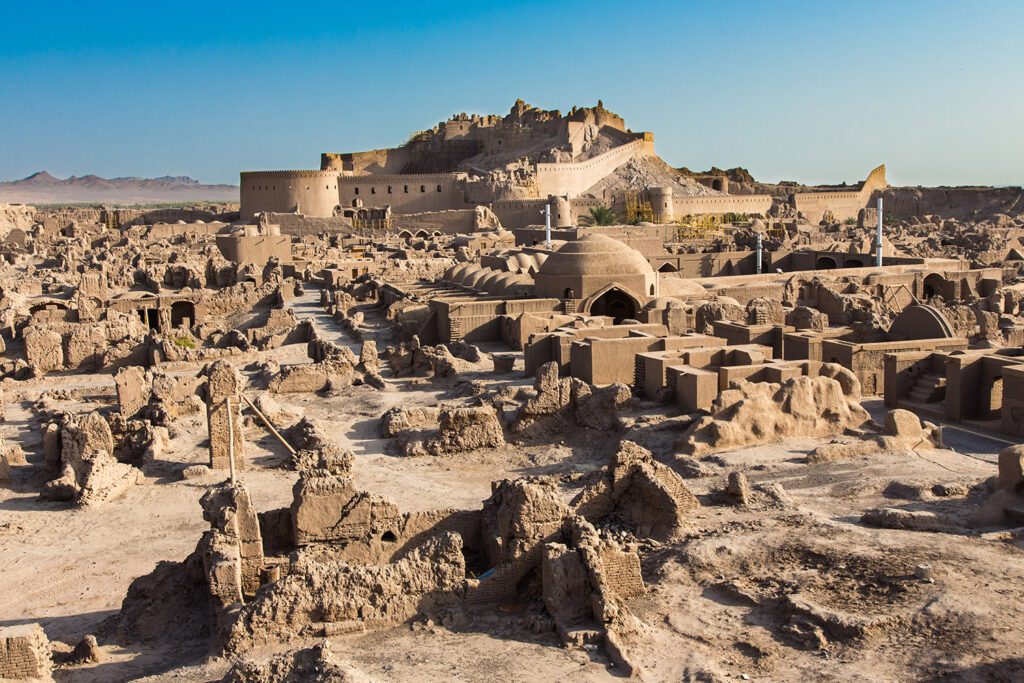
Pasargadae
The Pasargadae region in Fars is a historically significant area with notable ancient structures, primarily recognized for being the burial place of Cyrus of the Achaemenid era. The Tomb of Cyrus in Pasargadae, despite its simplicity, exhibits remarkable architecture constructed in the style of ancient sanctuaries.

Among other notable attractions in the historical Pasargadae area there are the royal garden terraces, the four-winged guardian relief, the Gatehouse, stone tower, Tall-e Takht, and the Muzaffari Caravanserai. This collection of historical sites in Fars Province stands out as one of the most popular tourist destinations in Iran.
Soltaniyeh
Gonbad-e Sultanieh in Zanjan is a historical mausoleum belonging to Sultan Mohammad Khodabandeh (Oljaytu), the eighth Ilkhanid king. This mausoleum is considered one of the most prominent examples of double shell domes in Iranian architecture, and its brick dome is the third largest dome in the world.

One of the most beautiful features of Gonbad-e Sultanieh is its turquoise-blue tiles that shine like a jewel in the plane. The octagonal structure is topped with a 50 meters high dome, encircled by eight minarets. The interior decorations and architectural style of Gonbad-e Sultanieh are exceptionally unique during the Ilkhanid period.
Bisotun
Bisotun is considered a treasury of Iran’s historical heritage, due to the presence of historical relics dating back approximately four thousand years and continuing until a few hundred years ago. The Bisotun Inscription recounts the victory of Darius the Great over Gaumata and is the most important text from the Achaemenid period.

Mount Bisotun, alongside its historical aspects, has had a profound influence on Persian literature and is remembered among Iranians as a sacred mountain. One of these influences can be seen in the epic poem “Khosrow and Shirin” by Nizami Ganjavi, where the abundant love of Farhad for Shirin is depicted. In this story King Khosrow orders a skilled sculptor named Farhad to carve a channel in Mount Bisotun and then finds out that he fell in love with the same princess that Khosrow loves. The love triangle ends tragically as Farhad takes his own life after being falsely informed of the death of Shirin.
Armenian Monastic Ensembles of Iran
The Armenian churches in East and West Azerbaijan provinces are among the oldest religious sites in Iran. The oldest of these churches date back to the 7th century AD, and their construction continued until the 14th century AD. These churches are called Qareh Kelisa, the Church of Saint Stepanos, and the Church of Dzordzor. These churches are known for their architecture as well as their cultural significance, as they served as places of pilgrimage and worship for Armenian people.

Qare Kelisa, also known as The Monastery of Saint Thaddeus, is the oldest of the three and is considered one of the oldest church buildings in the world. The Church of Saint Stepanos is located 17 kilometers west of the city of Jolfa and three kilometers south of the Aras River. The Church of Dzordzor, also known as the Church of Holy Mary, is located in Maku.
Shushtar Historical Hydraulic System
One of the most prominent reasons for the registration of the hydraulic structures of Shushtar on UNESCO’s World Heritage List is the advanced design system of these structures in ancient times. During the Achaemenid and Sasanian periods, the hydraulic structures of Shushtar in Khuzestan were used to maximize the utilization of water resources.
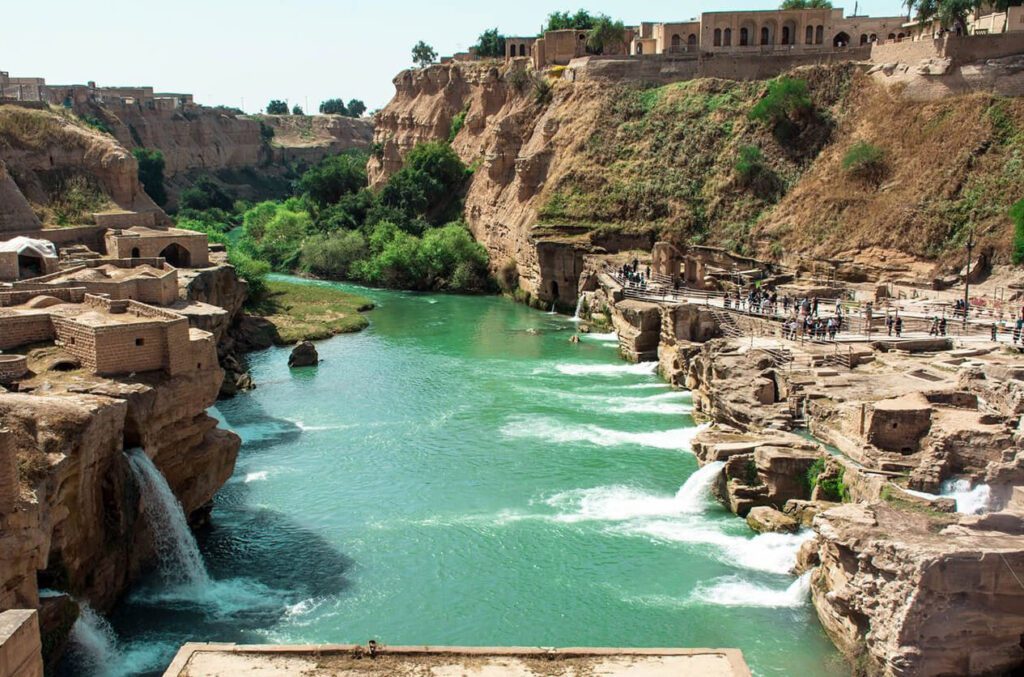
The ingenuity of architectural design and creativity in constructing these structures now astonishes people worldwide. The canals, mills, bridges, dams, and extensive tunnels, equipped with hydraulic systems for proper water management and prevention of waste, stand as unparalleled examples of architectural marvels.
Tabriz Historic Bazaar Complex
The historic Bazaar of Tabriz has a rich history as it is situated along the trade route of the Silk Road. Today, it remains the most significant commercial center in the city of Tabriz. There are over 5500 covered shops and many historical structures such as mosques and schools within this bazaar. Traditional Iranian crafts and industries, including handicraft production and carpet weaving, play an important role in the prosperity of the Bazaar of Tabriz.

Sheikh Safi al-din Khānegāh and Shrine Ensemble in Ardabil
The mausoleum of Sheikh Safi al-Din Ardabili, located in Ardabil province, is one of the oldest Sufi shrines in Iran. Its historical roots, like many other Islamic mausoleums in Iran, goes back to the Safavid period. In the past, the mausoleum of Sheikh Safi al-Din also served as the residence and monastery of this eminent mystic. According to his own wishes, Sheikh Safi’s remains were interred in this building after his passing.

Within the mausoleum, the tombs of Shah Abbas Safavi, his royal descendants are also located here. The architectural design of the interior of this mausoleum incorporates symbols of Sufism, and various sections of the entrance to the tomb feature distinct symbols of the Sufi order. Various forms of artistic expressions, including tilework, stucco and mirror ornamentation can be observed within this historical structure.
The Persian Garden
The Persian Gardens are examples of the diversity of garden design in different climates, while following a set of principles dating back to the time of Cyrus the Great in 6th century B.C. These Gardens are always divided into four sectors, called Chahar-Bagh and water features play an important role for irrigation and ornamentation.

Especially in the hot and arid regions, the gardens resembled the image of paradise, and have influenced the art of garden design as far as India and Spain. The inscribed gardens are as followed:
1. Pasargadae Gardens in Marvdasht, which are remains of the garden in Achaemenid period and shows the early Chahar-Bagh structure
2. Eram Garden in Shiraz, has been inspiring for many famous Persian poets, such as Hafez.
3. Shazdeh Garden of Mahan in Kerman, is a delightful paradise in the middle of a hot desert. It is built in several levels and the water channels resemble small cascades that also enjoy fountains that use gravity force to function.
4. Chehel Sotoun Garden in Isfahan has the most magnificent pavilion. The name Chehel Sotoun means 40 pillars, while the building has only 20. The other 20 is counted from the reflection of the palace in the courtyard pool.
5. Fin Garden in Kashan is an excellent example of water management in Persian gardens. Its water channels are beautifully constructed and small fountains all around the garden function only with the force of gravity. The Fin Garden also carries historical significance as the place of assassination of Amir Kabir, famous prime minister of the Qajar era.
6. Abbasabad Garden in Behshahr is the only garden in the selection that is not located in a desert climate. The remains of a palace is located on a small hill in the middle of a large water reservoir, which is completely submerged in the water in rainy seasons.
7. Dolat-Abad Garden in Yazd owns one of the tallest wind catchers (Baad-gir) in the country. These wind catchers work as ventilation mechanisms to provide a breeze during hot summer days.
8. Akbarieh Garden in Birjand is famous for its tall pine trees that are symmetrically standing. The pavilion is also interesting, as it combines Iranian architecture with Russian styles.
9. Pahlavanpur Garden in Mehriz is the only garden that does not have a royal history. The water stream in the middle of the garden comes from a UNESCO World Heritage inscribed qanat, called Hassanabad Moshir Qanat, and is only for the aesthetic of the garden and creating a delightful environment. The irrigation water is provided from other sources.
Orienttrips Experience
Book Daily Shiraz Tour
Masjed-e Jāmé of Isfahan
The Jameh Mosque of Isfahan, also known as Friday Mosque of Isfahan or the Ancient Jameh Mosque, is one of the most important and oldest religious edifices in Iran. The current facade of the mosque is attributed to the Seljuk period, but it also shows renovations and additions, especially from the Safavid era.

This mosque stands as one of the most prominent architectural marvels in Iran and the world. Due to the fact that different sections of the mosque were constructed and developed in various historical periods, the complex serves as a vast museum, providing insight into the evolution and transformation of Iranian religious architecture during the Islamic era and even before. Archaeological excavations suggest that this mosque likely served as a significant religious center prior to the Arab conquest, functioning as one of the fire temples of Isfahan.
Gonbad-e Qabus
Gonbad-e Qabus Tower is a structure with a history of over 1000 years and is the tallest brick tower in the world. It is located about three kilometers from the city of Gorgan. The exceptional architecture of Gonbad-e Qabus Tower has contributed significantly to its widespread renown. Standing on a hill, the tower reaches a height of 60 meters and was named after the king of Gorgan during the rule of the Ziyarid dynasty. The king Qabus built this structure to showcase the magnificence of his reign. While there are accounts suggesting that the tower was initially intended as a mausoleum for Qabus, no physical remains have been found within the tower.

The outstanding architecture of Gonbad-e Qabus Tower is considered an example of early memorial structures in Iran. Its distinguished design highlights the advancements in engineering and mathematics during the Islamic era in Iran. With a height of 53 meters, the tower has stood the test of time, and no brick structure throughout history has been able to rival it. The structure of Gonbad-e Qabus Tower is recognized worldwide as a masterpiece of ancient Iranian engineering.
Golestan Palace
Golestan Palace in Tehran is one of the most famous attractions in the city. It is the only cultural and historical site in the capital of Iran that is registered on the UNESCO World Heritage List. The history of the Golestan Palace dates back over 400 years, with its initial construction during the Safavid era. However, the current form of the palace was built during the Zand period under the orders of Karim Khan, and its interior architecture and expansions were carried out by Agha Mohammad Khan Qajar. The architecture of Golestan Palace bears abundant signs of the Qajar period.

This historical building, along with its museums and various historical sections, serves as a symbol of the culture and civilization of Iran over the past few centuries and the Qajar era.
Shahr-e Sukhteh
The ancient city of Shahr-e Sukhteh in Sistan and Baluchestan is one of the oldest cities in the world, and it enjoys great popularity among archaeologists worldwide. With a history spanning over 6,000 years, Shahr-e Sukhteh is the seventeenth Iranian site registered on the UNESCO World Heritage list for its historical and cultural significance.
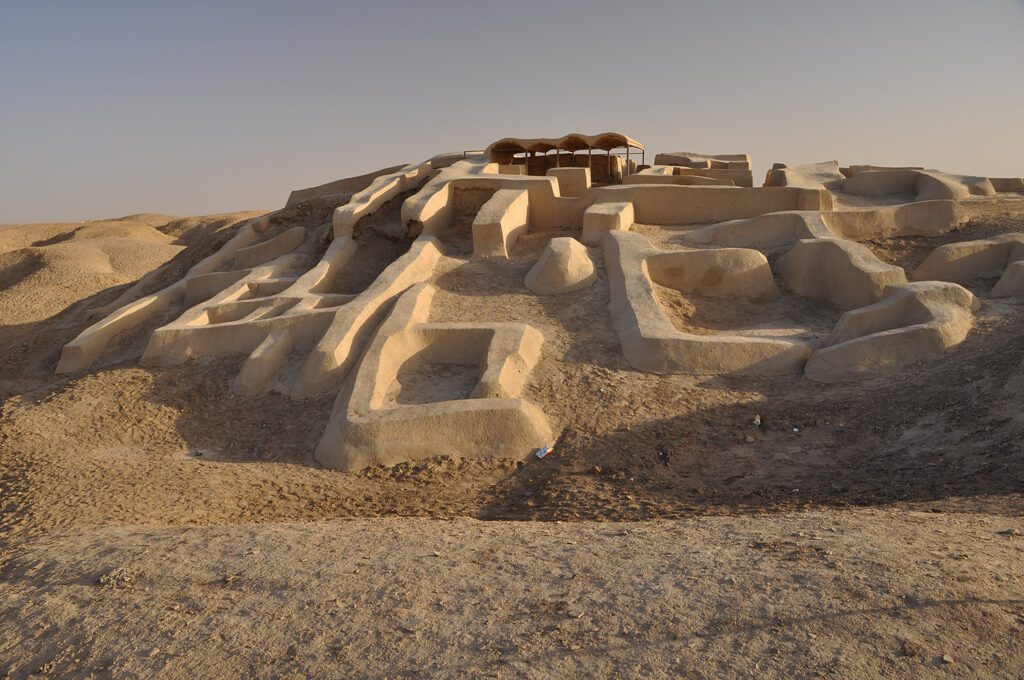
Extensive research by global archaeologists reveals evidence of an advanced and civilized city in the location of Shahr-e Sukhteh during ancient times. This ancient site, located south of the city of Zabol, was a significant hub along the ancient trade routes of the Iranian plateau, leading to a thriving commerce and trade in the region.
The most remarkable findings in the city of Shahr-e Sukhteh indicate advancements in various fields, including the medical sciences. Among the artifacts discovered from the remains of the inhabitants of Shahr-e Sukhteh, evidence of brain surgery and artificial eye have been found. Also, a pottery vase with depiction of a goat jumping, is considered to be the earliest example of animation in history. This pottery piece is currently at the National Museum of Iran in Tehran.
Cultural Landscape of Maymand
The rocky village of Meymand is considered one of the world’s earliest human settlements. For ancient inhabitants of this village, natural elements like the sun and the sacred mountain held great significance, and they lived by carving into the rocks and cliffs.

Even after many centuries, traces of excavations are still visible within the stone houses of Meymand. While the precise history of the rocky village of Meymand is not entirely known, the life of ancient Aryan tribes in this region during ancient times has been noted by archaeologists. There are two possibilities regarding the earliest inhabitants of Meymand.
Firstly, the ethnic groups residing in this area may date back to the Median period. In the second theory, the existence of stone houses is attributed to the settlement of ancient Mazdaean worshipers in this village. In the vicinity of Meymand, there are other historical sites, such as an ancient cemetery.
The Ancient City of Susa
The ancient city of Susa was one of the oldest capitals of ancient Iran. It is located in the Khuzestan province and archaeological excavations in this area have revealed 15 different historical layers related to 15 ancient cities from the Elamite, Achaemenid, Seleucid, Parthian, and Sasanian periods. The Code of Hammurabi, the famous Babylonian stele was rediscovered here, as it was taken as plunder by Persians.
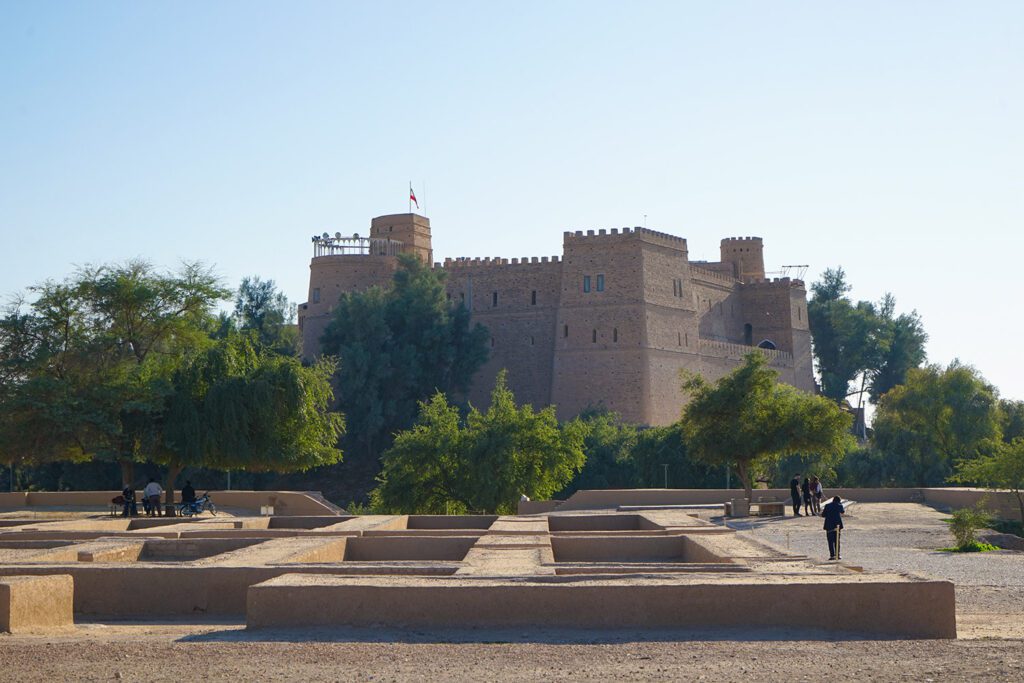
Some of the historical landmarks and ancient structures in the city of Susa include the Apadana Palace, the Elamite Village, the Grand Mosque of Susa, the Acropole Mound, and the Castle of the French. The ancient city of Susa is among the most popular tourist destinations in Iran, attracting both domestic and international visitors, while its valuable artifacts are on display in many prominent museums in the world, such as the Louvre and the British Museum.
The Persian Qanat
Qanats are underground channels, built to transfer water from its source at the aquifer to the surface in the desired area. Iranian Qanats stand out due to their age, architectural style, depth, length, and distinctive characteristics. For instance, the “Qanat-e Qasabeh Gonabad ” is the deepest Qanat in Iran, with a mother well reaching a depth of 350 meters. The “Zarch Qanat” in Yazd, with a length of 100 kilometers, is the longest.

One of the most remarkable Qanats in Iran is the “Ardestan’s Moon Qanat,” which has two levels and is over 800 years old. The water of the two levels do not mix on the way to the opening and each have different stakeholders. Other registered Qanats in this list include the Hasanaabad Moshir in Mehriz, Ibrahimabad in Arak, Baladeh Ferdows Qanat, two Qanats in Meymeh and Vazvan in Esfahan, and finally Jupar and Qasemabad in Kerman province.
Among the provinces of Iran Khorasan and Kerman provinces have the most number of Qanats, while masters of Yazd and Bam cities were famous for their skillfulness in traditional engineering of the wells and the channels.
Lut Desert
Dasht-e Lut, also known as Lut Desert, is recognized as the 25th largest desert around the world and spans parts of the provinces of Sistan and Baluchestan, South Khorasan, and Kerman. In the extensive expanse of Dasht-e Loot, archaeologists have discovered remnants of a civilization dating back four thousand B.C.

Also, remains of earliest Qanat structures are present there. Among the most beautiful natural features in Dasht-e Lut, we should mention its impressive “Kalouts” or aeolian yardang landforms. Kavir-e Khor” or “Khor Salt Flat,” “Lut Desert,” and “Shahdad Desert.” The volcanic cones, Lut’s sand dunes in Shahdad, sandy plains, and salt flats are other stunning sights in Lut Desert.
Historic City of Yazd
The city of Yazd, with its numerous religious structures such as mausoleums, Zoroastrian pilgrimage sites, historical houses, ancient water reservoirs, historic gardens, and traditional markets, is considered one of the oldest cities in the world. Yazd is known by titles such as the largest city of raw brick, the city of wind catchers, and the center of knowledge. The ancient and earthen architecture of this city is still intact in various areas, and the people of Yazd are regarded as some of the most cultured and authentic people of Iran.

Gardens of Dolat Abad in Yazd, Pahlavanpour in Mehriz, and the Qanats of Zarch and Hasan Abad Mosheer in the province of Yazd have been already in the UNESCO World Heritage List. Yet the city as a whole was inscribed to preserve its outstanding culture and traditions as living testimony of intelligent use of limited resources in the desert.
Sassanid Archaeological Landscape of Fars Region
The Sasanian Archaeological Landscape of Fars encompasses eight ancient sites located in three regions: Firuzabad, Bishapur, and Sarvestan in the southwest of Fars province. These areas have housed prominent historical structures built around 220s to 650s A.D.

The artistic harmony of the structures and the natural topography of the region are examples of the influence of Achaemenid and Parthian cultural traditions, as well as the imprint of Roman arts that greatly influenced Islamic-era architecture.The eight historical sites within the Sasanian Archaeological Landscape of Fars are as followed:
1. Qal’eh Dokhtar Castle, dedicated to the Goddess Anahita by Ardeshir Babakan, located 6 kilometers from the Firuzabad on Shiraz Road.
2. Ardeshir Babakan’s Royal Relief in Firuzabad.
3. Ardeshir Babakan’s Victory Relief over Ardavan in Firuzabad.
4. Gour City, a completely round city and the capital established by Ardeshir Babakan, situated 3 kilometers from the city of Firuzabad.
5. Ardeshir Babakan’s Palace in the historical city of Gour, near Firuzabad.
6. Bishapur City in the central district of Kazeroon.
7. Shapur Cave, located 6 kilometers from the historical city of Bishapur, houses a three meters statue of Shapur the First inside.
8. Sasanian Palace of Sarvestan, located 9 kilometers south of Sarvestan city.
Hyrcanian Forests
The Hyrcanian Forests, located along the southern coast of the Caspian Sea, are scattered throughout the northern provinces of Iran. These Forests are a natural treasure as important ecological regions of great significance, spanning approximately 800 kilometers in length and varying in width from 20 to 70 kilometers. A small portion of this expanse lies within the country of Azerbaijan. The diversity of plant and animal species underscores the importance of the Hyrcanian Forests.

Among the various species of trees and plants in the Hyrcanian forests, there are both broad-leaved and coniferous trees, many of them endemic to this region. Depending on the altitude of different parts of the forest, the type of vegetation varies as they stretch from the lowlands to the mountainous areas. This ecoregion is the main green resting area for birds migrating between central-northern Russia and Africa. Other animals such as brown bear, Persian leopard, wolf, golden jackal, Eurasian lynx also
Trans-Iranian Railway
The Iranian National Railway spans approximately 1400 kilometers, traversing from the north to the southwest of Iran. Along its route, it crosses over bridges, rivers, mountainous areas, forests, and plains. In its path, there are four different climatic zones and prominent historical and natural attractions. The railway line, known as the North-South Railway, commences from the port of Torkaman (formerly the Shah port) by the Caspian Sea and stretches to the port of Imam Khomeini (Shapour port) on the edge of Persian Gulf. It was constructed under a massive project, a successful collaboration between the government of Reza Shah Pahlavi and 43 contracting companies. The construction took 11 years, since the project faced considerable challenges due to its extensive scope and intricate engineering, particularly in the mountainous regions.

The Trans-Iranian Railway evokes feelings of pride for Iranian people, since it was completed without the involvement of foreign resources. Instead of borrowing from foreign banks or handing it over, the Iranian government managed to fund the entire project through tax revenues on goods such as tea and sugar. Different sections of the line carry different stories, for example the “Seh Khatt-e Tala” (three lines of gold) in the north branch refer to the challenging section of the Trans-Iranian Railway, where three lines are constructed on a single mountain side and trains twist and turn in order to ascend and descend. This particular stretch was the most expensive segment of the entire railway project.
Cultural Landscape of Hawraman/Uramanat
Uramanat, or Hawraman, is a historical region characterized by its picturesque stepped architecture, situated between the provinces of Kurdistan and Kermanshah. The core of the cultural landscape of Uramanat encompasses the Central-Eastern Valley (Zhaverud and Takht, in Kurdistan Province); and the Western Valley (Lahun, in Kermanshah Province). In total, there are over 700 villages in the Uramanat region, where the inhabitants have preserved their traditional customs, and wear authentic attire.

The discovered ancient artifacts in the Uramanat region provide evidence of its antiquity, dating back to the era of ancient Iran. The village of Hajij in Uraman Takht is the site of discovered fossils from the Paleolithic period, which makes this village considered the oldest part of Hawraman.
The Persian Caravanserai
Just recently in 2023, a combination of 54 historical caravanserais in 24 provinces across Iran were inscribed as one element of World Heritage. Caravanserais are important forms of Iranian architecture that have facilitated the development of routes and the needs associated with travel in ancient times. None of the inscribed caravanserais have repetitive designs, therefore, they manifest the creativity and architectural genius of Iranians throughout history.

Persian caravanserais were directly involved in social and cultural transformations, with their influence being observed in literature, poetry, painting, miniature art, music, and of course, architecture. There are legends around Shah Abbas of Safavid dynasty, depicting his travels on merchants and pilgrim routes to point where new caravanserais should be established, creating a web of accessible resting areas for travelers.






